Located in California’s Mojave Desert, Red Rock Canyon State Park is on the southernmost tip of where the Sierra Nevada Mountains converge with the El Paso Range, approximately 125 miles north of Los Angeles and 25 miles north of Mojave.
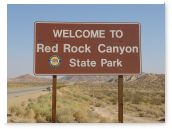 This beautiful and scenic wonder of California was established as Kern County's first State Park in 1968. It currently encompasses an area of over 25,000 acres that spans both sides of Highway 14. During the 1920s, this highway was simply a road blacktopped with oil sand; paving was begun in 1931 and finally completed in 1958. Today, the four-lane Highway 14 traverses the canyon from south to north as it takes travelers from Los Angeles to Lone Pine and points beyond. Although its name and number have changed numerous times over the years, State Highway 14 has been so-called since 1964. For thousands of years, however, Native Americans used the gash situated at the western edge of the El Paso Mountain range as a trade route. The area was once home to the Kawaiisu Indians whose petroglyphs can be found in the El Paso Mountains.
This beautiful and scenic wonder of California was established as Kern County's first State Park in 1968. It currently encompasses an area of over 25,000 acres that spans both sides of Highway 14. During the 1920s, this highway was simply a road blacktopped with oil sand; paving was begun in 1931 and finally completed in 1958. Today, the four-lane Highway 14 traverses the canyon from south to north as it takes travelers from Los Angeles to Lone Pine and points beyond. Although its name and number have changed numerous times over the years, State Highway 14 has been so-called since 1964. For thousands of years, however, Native Americans used the gash situated at the western edge of the El Paso Mountain range as a trade route. The area was once home to the Kawaiisu Indians whose petroglyphs can be found in the El Paso Mountains.
Canyon tributaries are unique with vivid colors and the park's floral displays are stunning, especially following wet winters. Wildlife in the area includes roadrunners, hawks, lizards, mice and squirrels. Unique rock formations feature layers of red and white sediment, as well as pink and black volcanic rock
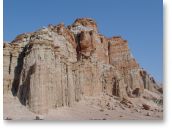 deposited in an ancient inland lake that was uplifted by the Garlock Fault. Streams and rivers carved these stunning canyons and cliff faces, while the fluted folds are the result of wind and rain eroding the softer materials beneath the harder lava flow layer. These colorful desert cliffs, buttes and spectacular rock formations adorn both the east and west sides of Highway 14 and served as landmarks for the 20-mule team freight wagons of the early 1870s that skirted around the El Paso Mountains and Red Rock Canyon. The stagecoach lines that existed until 1909 also passed through the canyon, as did the Cerro Gordo silver shipments that helped build the early commerce of Los Angeles. In 1873, Remi Nadeau even built one of his Cerro Gordo Freight Company stations in Red Rock Canyon at the later site of Ricardo. The canyon was also used as a passage in driving large flocks of sheep northward, as a railroad route, and later as a truck stop.
deposited in an ancient inland lake that was uplifted by the Garlock Fault. Streams and rivers carved these stunning canyons and cliff faces, while the fluted folds are the result of wind and rain eroding the softer materials beneath the harder lava flow layer. These colorful desert cliffs, buttes and spectacular rock formations adorn both the east and west sides of Highway 14 and served as landmarks for the 20-mule team freight wagons of the early 1870s that skirted around the El Paso Mountains and Red Rock Canyon. The stagecoach lines that existed until 1909 also passed through the canyon, as did the Cerro Gordo silver shipments that helped build the early commerce of Los Angeles. In 1873, Remi Nadeau even built one of his Cerro Gordo Freight Company stations in Red Rock Canyon at the later site of Ricardo. The canyon was also used as a passage in driving large flocks of sheep northward, as a railroad route, and later as a truck stop.
Some gold prospecting was done in the canyon during the 1860s, but it was not until Rudolf Hagen discovered gold in 1893 that hundreds of miners took up placer mining. It was Rudolf Hagen who built the Ricardo stopover (now a campground) in the southern area of the canyon. Charley Koehn, known as “Bismarck of the Desert” and “The Wild Dutchman”, homesteaded at Kane Springs from 1892 until his death. He supplied garden vegetables to the gold diggers, and later, when film companies appeared in the area, it was Koehn who supplied them with the necessary wagons and mules.
The heart of Red Rock Canyon's geologically sculpted strata dates back millions of years, with Red Cliffs Natural Preserve dating back 12 to 12.5 million years, Hagen Canyon about 11 million years, and Ricardo about 10 million years.
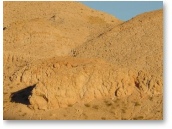 At least 88 species of fossil plants and animals have been identified, and over 6,000 specimens have been collected from Red Rock State Park, all from what geologists call the Dove Spring Formation of the Ricardo Group. This fossil-rich strata formation was deposited primarily by streams, floodplains, lakes, ponds, alluvial outwash and periodic volcanic activity. Although the area is rich in fossil specimens, no dinosaur remains have been found anywhere near Red Rock Canyon. This fact, however, did not deter Steven Spielberg from filming the opening scene of the first Jurassic Park movie at Red Rock Canyon. In fact, Red Rock Canyon has through the years been a frequent and important backdrop for many movies (especially Westerns), videos, television shows and commercials.
At least 88 species of fossil plants and animals have been identified, and over 6,000 specimens have been collected from Red Rock State Park, all from what geologists call the Dove Spring Formation of the Ricardo Group. This fossil-rich strata formation was deposited primarily by streams, floodplains, lakes, ponds, alluvial outwash and periodic volcanic activity. Although the area is rich in fossil specimens, no dinosaur remains have been found anywhere near Red Rock Canyon. This fact, however, did not deter Steven Spielberg from filming the opening scene of the first Jurassic Park movie at Red Rock Canyon. In fact, Red Rock Canyon has through the years been a frequent and important backdrop for many movies (especially Westerns), videos, television shows and commercials.
Of the more than 100 movies that have been filmed at Red Rock Canyon, the majority of them have been Westerns. One of the earliest Westerns filmed here was Wild Horse Canyon (1925), starring the great stuntman Yakima Canutt. This was followed the next year by Paramount’s Born to the West and Hands Up! Besides Paramount, the other major studios that have used this location include Universal, Warner Brothers, MGM, RKO and Columbia. Even the minor studios of the 1930s and 1940s, such as Tiffany, Monogram, and especially Republic Pictures, took advantage of the canyon's beautiful scenery. William Wyler, Michael Curtiz, Henry Hathaway, Karl Freund, Richard Thorpe, Howard Hughes and Alfred Hitchcock are some of the century’s major filmmakers who have directed their casts in Red Rock Canyon.
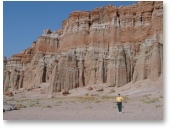 During the 1930s and 1940s, a multitude of B-Westerns were filmed at Red Rock Canyon including Ken Maynard's Tombstone Canyon (1932) and The Strawberry Roan (1933), John Wayne's The Lawless Frontier (1934) and Pals of the Saddle (1939), William Boyd's Hop-A-Long Cassidy (1935) and The Texas Trail (1937), Robert Livingston's Gunsmoke Ranch (1937) and Hit the Saddle (1937), George O'Brien's Painted Desert (1938), Jack Randal's Where the West Begins (1938),
During the 1930s and 1940s, a multitude of B-Westerns were filmed at Red Rock Canyon including Ken Maynard's Tombstone Canyon (1932) and The Strawberry Roan (1933), John Wayne's The Lawless Frontier (1934) and Pals of the Saddle (1939), William Boyd's Hop-A-Long Cassidy (1935) and The Texas Trail (1937), Robert Livingston's Gunsmoke Ranch (1937) and Hit the Saddle (1937), George O'Brien's Painted Desert (1938), Jack Randal's Where the West Begins (1938),
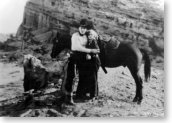 and Gene Autry's Melody Ranch (1940), The Singing Hill (1941) and The Big Sombrero (1949). Although some Western stars of this period had only one entry filmed at the canyon, many had at least two and some even had three. Roy Rogers appears to have had the most, with at least seven oaters for Republic Pictures including Wall Street Cowboy (1939), Colorado (1940), Young Buffalo Bill (1940) and Man from Cheyenne (1942) directed by Joseph Kane, and Grand Canyon Trail (1948), In Old Amarillo (1951) and Pals of the West (1951) directed by the great serial master, William Witney.
and Gene Autry's Melody Ranch (1940), The Singing Hill (1941) and The Big Sombrero (1949). Although some Western stars of this period had only one entry filmed at the canyon, many had at least two and some even had three. Roy Rogers appears to have had the most, with at least seven oaters for Republic Pictures including Wall Street Cowboy (1939), Colorado (1940), Young Buffalo Bill (1940) and Man from Cheyenne (1942) directed by Joseph Kane, and Grand Canyon Trail (1948), In Old Amarillo (1951) and Pals of the West (1951) directed by the great serial master, William Witney.
Red Rock Canyon not only appears on the big screen in B-Westerns, but also in serials. Six major serials to have used the canyon include three from Republic and three from Universal Pictures. Half of these had Western themes and half were sci-fi flicks.
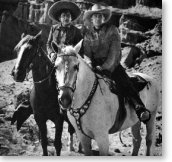 The three Western serials were Republic Pictures' 12-chapter Zorro Rides Again (1937) and the 15-chapter The Lone Ranger Rides Again (1939), both directed by William Witney and John English, and Universal Pictures' 15-chapter Riders of Death Valley (1941) directed by Ford Beebe and Ray Taylor. Universal's two sci-fi entries both starred Larry 'Buster' Crabbe: the 12-chapter Buck Rogers (1939) with Constance Moore and directed by Ford Beebe and Saul A. Goodkind, and the 12-chapter Flash Gordon Conquers the Universe (1940) with Carol Hughes and directed by Ford Beebe and Ray Taylor. Republic's sci-fi serial was the 12-chapter Radar Men from the Moon (1952) directed by Fred Brannon and starring George Wallace and Aline Towne.
The three Western serials were Republic Pictures' 12-chapter Zorro Rides Again (1937) and the 15-chapter The Lone Ranger Rides Again (1939), both directed by William Witney and John English, and Universal Pictures' 15-chapter Riders of Death Valley (1941) directed by Ford Beebe and Ray Taylor. Universal's two sci-fi entries both starred Larry 'Buster' Crabbe: the 12-chapter Buck Rogers (1939) with Constance Moore and directed by Ford Beebe and Saul A. Goodkind, and the 12-chapter Flash Gordon Conquers the Universe (1940) with Carol Hughes and directed by Ford Beebe and Ray Taylor. Republic's sci-fi serial was the 12-chapter Radar Men from the Moon (1952) directed by Fred Brannon and starring George Wallace and Aline Towne.
Besides being a favorite locale for the B-Western and serial genres, Red Rock Canyon has also appeared in numerous A-Western productions such as Calamity Jane and Sam Bass (1949) starring Yvonne De Carlo and Howard Duff, The Last Bandit (1949) and The Savage Horde (1950) both starring William Elliott, Davy Crockett, Indian Scout (1950) starring George Montgomery,
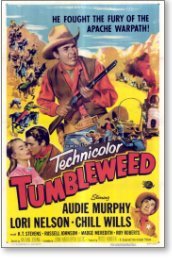 San Antone (1953) starring Rod Cameron, Law and Order (1953) starring Ronald Reagan, Tumbleweed (1953), Drums Across the River (1954) and Apache Rifles (1964) all three starring Audie Murphy (the most decorated soldier and Congressional Medal of Honor winner of WWII), The Bounty Hunter (1954) starring Randolph Scott, Dakota Incident (1956) starring Dale Robertson, The Fastest Gun Alive (1956) starring Glenn Ford, Gun Battle at Monterey (1957) starring Sterling Hayden, Apache Territory (1958) starring Rory Calhoun, The Big Country (1958) starring Gregory Peck, Man of the West (1958) starring Gary Cooper, and Four for Texas (1963) starring Frank Sinatra and Dean Martin. This last entry was somewhat of a nonsensical Sinatra-Martin romp set in the Old West, but its entire opening scene footage was shot at the colorful Red Rock Canyon.
San Antone (1953) starring Rod Cameron, Law and Order (1953) starring Ronald Reagan, Tumbleweed (1953), Drums Across the River (1954) and Apache Rifles (1964) all three starring Audie Murphy (the most decorated soldier and Congressional Medal of Honor winner of WWII), The Bounty Hunter (1954) starring Randolph Scott, Dakota Incident (1956) starring Dale Robertson, The Fastest Gun Alive (1956) starring Glenn Ford, Gun Battle at Monterey (1957) starring Sterling Hayden, Apache Territory (1958) starring Rory Calhoun, The Big Country (1958) starring Gregory Peck, Man of the West (1958) starring Gary Cooper, and Four for Texas (1963) starring Frank Sinatra and Dean Martin. This last entry was somewhat of a nonsensical Sinatra-Martin romp set in the Old West, but its entire opening scene footage was shot at the colorful Red Rock Canyon.
Although Red Rock Canyon's terrain is particularly suited for Westerns of all types, this locale has also been widely used for a variety of other genres including horror, crime, comedy, suspense, adventure, historical and particularly sci-fi. Undoubtedly, the finest classic horror film to use Red Rock Canyon as a backdrop is Universal's The Mummy (1932) starring Boris Karloff.
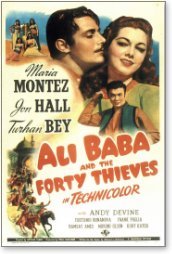 The canyon's scenic desert cliffs, buttes and spectacular rock formations made for a perfect replication of Egypt's Valley of the Kings. Twenty-two years later, 20th Century Fox's The Egyptian (1954) starring Jean Simmons and Victor Mature was also filmed at the canyon for the same reason, and this time in CinemaScope and in color.
The canyon's scenic desert cliffs, buttes and spectacular rock formations made for a perfect replication of Egypt's Valley of the Kings. Twenty-two years later, 20th Century Fox's The Egyptian (1954) starring Jean Simmons and Victor Mature was also filmed at the canyon for the same reason, and this time in CinemaScope and in color.
Red Rock Canyon's arid appearance doubled for the Arizona desert in Warner Brothers' The Petrified Forest (1936) starring Leslie Howard, Bette Davis and Humphrey Bogart. Howard and Bogart recreated their Broadway roles, as Bogart played Duke Mantee, an escaped gangster, who holds writer Howard, dreamer Davis, and others hostage in a roadside gas station and Bar-B-Q in the Arizona desert. The canyon's desert appearance is also highlighted in Universal's colorful escapism production of Ali Baba and the Forty Thieves (1944) starring Maria Montez and Jon Hall.
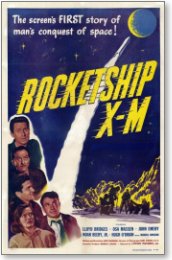 On the comedy screen, Red Rock Canyon shows up in the two MGM features Go West (1941) starring the Marx Brothers and The Long, Long Trailer (1954) starring Lucille Ball and Desi Arnaz. The canyon can also be seen in Universal's spy thriller Saboteur (1942) directed by Alfred Hitchcock and starring Robert Cummings.
On the comedy screen, Red Rock Canyon shows up in the two MGM features Go West (1941) starring the Marx Brothers and The Long, Long Trailer (1954) starring Lucille Ball and Desi Arnaz. The canyon can also be seen in Universal's spy thriller Saboteur (1942) directed by Alfred Hitchcock and starring Robert Cummings.
With the advent of space exploration in the 1950s, sci-fi became a popular genre for Hollywood. The striking terrain of Red Rock Canyon made it an excellent extraterrestrial “on location” site for Lippert Pictures’ Rocketship X-M (1950) starring Lloyd Bridges and Hugh O'Brian, and Astor's Missile to the Moon (1959) starring Richard Travis. In the former, a spaceship headed to the moon is blown off-course to Mars, and in the latter a lunar expedition finds sinister females presiding over a race of moon-women. Red Rock Canyon offered a suitable landscape for both Mars and the Moon. In the years that followed, sci-fi reached higher levels of sophistication compared to the simple, sometimes adolescent, plots of the 1950s. These more sophisticated plots required realistic scenery, and Red Rock Canyon served as the perfect backdrop in the futuristic flicks Beneath the Planet of the Apes (1970) starring James Franciscus and Kim Hunter, and The Andromeda Strain (1971) starring Arthur Hill and David Wayne.
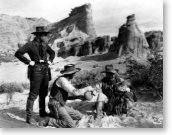 Made-for-TV movies became commonplace during the 1970s, and locations used for the big screen also became preferred locations for the small screen. Consequently, Red Rock Canyon appeared in such TV movies as ABC's Ordeal (1973), Westworld (1973), The Hanged Man (1974), Savages (1974) and The Godchild (1974). The latter is at least the seventh version of 3 Godfathers (1948). John Ford's 1948 version is considered by many to be the best, although the story loses its poignancy at the end as a result of John Wayne not being killed. Incidentally, two other prior versions of the movie were also filmed at Red Rock Canyon: Hell's Heroes (1929) and Three Godfathers (1936).
Made-for-TV movies became commonplace during the 1970s, and locations used for the big screen also became preferred locations for the small screen. Consequently, Red Rock Canyon appeared in such TV movies as ABC's Ordeal (1973), Westworld (1973), The Hanged Man (1974), Savages (1974) and The Godchild (1974). The latter is at least the seventh version of 3 Godfathers (1948). John Ford's 1948 version is considered by many to be the best, although the story loses its poignancy at the end as a result of John Wayne not being killed. Incidentally, two other prior versions of the movie were also filmed at Red Rock Canyon: Hell's Heroes (1929) and Three Godfathers (1936).
Although Red Rock Canyon became a recognizable backdrop in the made-for-TV movies of the 1970s, the canyon has appeared in episodes of many television shows including (alphabetically) Airwolf, Barnaby Jones, Battlestar Galactica, Bonanza, Branded, The FBI, Frontier Circus, Have Gun, Will Travel, The High Chaparral, Highway Patrol, Hondo, Laramie, Lassie, Lost in Space, Overland Trail, Questar, Rawhide, The Rebel, The Time Tunnel, Wagon Train, and Young Indiana Jones.
Today, visitors to this colorful State Park can enjoy picnicking, hiking, auto touring (along designated roadways), horseback riding, camping (Ricardo campground) and, of course, photography. Any visitor can capture the majestic beauty of this scenic locale on film as Hollywood production companies have done for nearly 85 years.